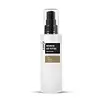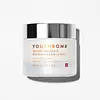What's inside
What's inside
 Key Ingredients
Key Ingredients

 Benefits
Benefits

 Concerns
Concerns

 Ingredients Side-by-side
Ingredients Side-by-side

Water
Skin ConditioningButylene Glycol
HumectantCaprylic/Capric Triglyceride
MaskingHelianthus Annuus Seed Oil
EmollientButylene Glycol Dicaprylate/Dicaprate
EmollientNiacinamide
SmoothingSodium Hyaluronate
Humectant1,2-Hexanediol
Skin ConditioningArachidyl Alcohol
EmollientBehenyl Alcohol
EmollientArachidyl Glucoside
EmulsifyingCyclomethicone
EmollientAdenosine
Skin ConditioningGlycerin
HumectantHydrogenated Lecithin
EmulsifyingSh-Oligopeptide-1
Skin ConditioningCopper Tripeptide-1
Skin ConditioningGlyceryl Stearate
EmollientPEG-100 Stearate
Polysorbate 60
EmulsifyingDiisostearyl Malate
EmollientDimethicone
EmollientMyrciaria Dubia Fruit Extract
Skin ConditioningEuterpe Oleracea Fruit Extract
Sorbitan Stearate
EmulsifyingAllantoin
Skin ConditioningXanthan Gum
EmulsifyingTocopheryl Acetate
AntioxidantLonicera Japonica Flower Extract
Skin ConditioningSolanum Lycopersicum Fruit Extract
AntioxidantLilium Tigrinum Extract
Skin ConditioningNelumbo Nucifera Seed Extract
AntimicrobialChrysanthemum Indicum Flower Extract
Skin ConditioningHydrolyzed Collagen
EmollientAcanthopanax Senticosus Root Extract
Skin ConditioningPunica Granatum Fruit Extract
AntioxidantPanax Ginseng Root Extract
EmollientCarthamus Tinctorius Flower Extract
Skin ConditioningCarbomer
Emulsion StabilisingDisodium EDTA
Arginine
MaskingMalva Sylvestris Flower Extract
Skin ConditioningBuddleja Davidii Extract
Skin ConditioningThymus Vulgaris Extract
PerfumingCamellia Sinensis Callus Culture Extract
PerfumingPhaseolus Radiatus Meristem Cell Culture Extract
Skin ConditioningPanax Ginseng Callus Culture Extract
Skin ConditioningEthylhexylglycerin
Skin ConditioningPyrus Malus Leaf Extract
Skin ConditioningTheobroma Cacao Extract
Skin ConditioningVanilla Planifolia Fruit Extract
Skin ConditioningFragaria Chiloensis Fruit Extract
Skin ConditioningPrunus Persica Fruit Extract
AbrasiveMusa Sapientum Fruit Extract
Skin ConditioningCocos Nucifera Oil
MaskingPrunus Domestica Fruit Extract
MoisturisingWater, Butylene Glycol, Caprylic/Capric Triglyceride, Helianthus Annuus Seed Oil, Butylene Glycol Dicaprylate/Dicaprate, Niacinamide, Sodium Hyaluronate, 1,2-Hexanediol, Arachidyl Alcohol, Behenyl Alcohol, Arachidyl Glucoside, Cyclomethicone, Adenosine, Glycerin, Hydrogenated Lecithin, Sh-Oligopeptide-1, Copper Tripeptide-1, Glyceryl Stearate, PEG-100 Stearate, Polysorbate 60, Diisostearyl Malate, Dimethicone, Myrciaria Dubia Fruit Extract, Euterpe Oleracea Fruit Extract, Sorbitan Stearate, Allantoin, Xanthan Gum, Tocopheryl Acetate, Lonicera Japonica Flower Extract, Solanum Lycopersicum Fruit Extract, Lilium Tigrinum Extract, Nelumbo Nucifera Seed Extract, Chrysanthemum Indicum Flower Extract, Hydrolyzed Collagen, Acanthopanax Senticosus Root Extract, Punica Granatum Fruit Extract, Panax Ginseng Root Extract, Carthamus Tinctorius Flower Extract, Carbomer, Disodium EDTA, Arginine, Malva Sylvestris Flower Extract, Buddleja Davidii Extract, Thymus Vulgaris Extract, Camellia Sinensis Callus Culture Extract, Phaseolus Radiatus Meristem Cell Culture Extract, Panax Ginseng Callus Culture Extract, Ethylhexylglycerin, Pyrus Malus Leaf Extract, Theobroma Cacao Extract, Vanilla Planifolia Fruit Extract, Fragaria Chiloensis Fruit Extract, Prunus Persica Fruit Extract, Musa Sapientum Fruit Extract, Cocos Nucifera Oil, Prunus Domestica Fruit Extract
Water
Skin ConditioningCoco-Caprylate/Caprate
EmollientNiacinamide
SmoothingCaprylic/Capric Triglyceride
Masking1,2-Hexanediol
Skin ConditioningButylene Glycol
HumectantGlycerin
HumectantHamamelis Virginiana Water
AstringentArachidyl Alcohol
EmollientGlyceryl Stearate
EmollientPEG-100 Stearate
Bakuchiol
AntimicrobialDimethicone
EmollientBehenyl Alcohol
EmollientPotassium Azeloyl Diglycinate
Skin ConditioningCarbomer
Emulsion StabilisingArachidyl Glucoside
EmulsifyingPentylene Glycol
Skin ConditioningAvena Sativa Kernel Extract
AbrasivePolyglutamic Acid
Skin ConditioningEthylhexylglycerin
Skin ConditioningHydrolyzed Rice Protein
Skin ConditioningSodium Hydroxide
BufferingHydrolyzed Pea
Skin ConditioningTeprenone
Skin ConditioningUndaria Pinnatifida Extract
Skin ConditioningTetrasodium Glutamate Diacetate
Sodium Benzoate
MaskingPhenethyl Alcohol
MaskingHarpagophytum Procumbens Root Extract
Skin ConditioningSodium Carrageenan
Emulsion StabilisingEquisetum Arvense Extract
AstringentGlycyrrhiza Glabra Root Extract
BleachingSalix Alba Bark Extract
AstringentMaris Sal
Skin ConditioningBacillus Ferment
Skin ConditioningCitric Acid
BufferingPotassium Sorbate
PreservativeAlchemilla Vulgaris Extract
AstringentWater, Coco-Caprylate/Caprate, Niacinamide, Caprylic/Capric Triglyceride, 1,2-Hexanediol, Butylene Glycol, Glycerin, Hamamelis Virginiana Water, Arachidyl Alcohol, Glyceryl Stearate, PEG-100 Stearate, Bakuchiol, Dimethicone, Behenyl Alcohol, Potassium Azeloyl Diglycinate, Carbomer, Arachidyl Glucoside, Pentylene Glycol, Avena Sativa Kernel Extract, Polyglutamic Acid, Ethylhexylglycerin, Hydrolyzed Rice Protein, Sodium Hydroxide, Hydrolyzed Pea, Teprenone, Undaria Pinnatifida Extract, Tetrasodium Glutamate Diacetate, Sodium Benzoate, Phenethyl Alcohol, Harpagophytum Procumbens Root Extract, Sodium Carrageenan, Equisetum Arvense Extract, Glycyrrhiza Glabra Root Extract, Salix Alba Bark Extract, Maris Sal, Bacillus Ferment, Citric Acid, Potassium Sorbate, Alchemilla Vulgaris Extract
 Reviews
Reviews

Ingredients Explained
These ingredients are found in both products.
Ingredients higher up in an ingredient list are typically present in a larger amount.
1,2-Hexanediol is a synthetic liquid and another multi-functional powerhouse.
It is a:
- Humectant, drawing moisture into the skin
- Emollient, helping to soften skin
- Solvent, dispersing and stabilizing formulas
- Preservative booster, enhancing the antimicrobial activity of other preservatives
Arachidyl Alcohol is a fatty alcohol made from peanut oil. It is an emollient, emulsifier, and thickener.
You'll most likely find this ingredient as an emulsifier in water-based cosmetics.
We don't have a description for Arachidyl Glucoside yet.
Behenyl Alcohol is a type of fatty alcohol (these are different from the drying, solvent alcohols).
Fatty Alcohols have hydrating properties and are most often used as an emollient or to thicken a product. They are usually derived from natural fats and oils; behenyl alcohol is derived from the fats of vegetable oils.
Emollients help keep your skin soft and hydrated by creating a film that traps moisture in.
In 2000, Behenyl Alcohol was approved by the US as medicine to reduce the duration of cold sores.
Learn more about Behenyl AlcoholButylene Glycol (or BG) is used within cosmetic products for a few different reasons:
Overall, Butylene Glycol is a safe and well-rounded ingredient that works well with other ingredients.
Though this ingredient works well with most skin types, some people with sensitive skin may experience a reaction such as allergic rashes, closed comedones, or itchiness.
Learn more about Butylene GlycolThis ingredient is an emollient, solvent, and texture enhancer. It is considered a skin-softener by helping the skin prevent moisture loss.
It helps thicken a product's formula and makes it easier to spread by dissolving clumping compounds.
Caprylic Triglyceride is made by combining glycerin with coconut oil, forming a clear liquid.
While there is an assumption Caprylic Triglyceride can clog pores due to it being derived from coconut oil, there is no research supporting this.
Learn more about Caprylic/Capric TriglycerideCarbomer is a polymer of acrylic acid. Its main role is to create a gel consistency.
A high amount of carbomer can cause pilling or balling up of products. Don't worry, most products contain 1% or less of carbomer.
Dimethicone is a type of synthetic silicone created from natural materials such as quartz.
What it does:
Dimethicone comes in different viscosities:
Depending on the viscosity, dimethicone has different properties.
Ingredients lists don't always show which type is used, so we recommend reaching out to the brand if you have questions about the viscosity.
This ingredient is unlikely to cause irritation because it does not get absorbed into skin. However, people with silicone allergies should be careful about using this ingredient.
Note: Dimethicone may contribute to pilling. This is because it is not oil or water soluble, so pilling may occur when layered with products. When mixed with heavy oils in a formula, the outcome is also quite greasy.
Learn more about DimethiconeEthylhexylglycerin (we can't pronounce this either) is commonly used as a preservative and skin softener. It is derived from glyceryl.
You might see Ethylhexylglycerin often paired with other preservatives such as phenoxyethanol. Ethylhexylglycerin has been found to increase the effectiveness of these other preservatives.
Glycerin is already naturally found in your skin. It helps moisturize and protect your skin.
A study from 2016 found glycerin to be more effective as a humectant than AHAs and hyaluronic acid.
As a humectant, it helps the skin stay hydrated by pulling moisture to your skin. The low molecular weight of glycerin allows it to pull moisture into the deeper layers of your skin.
Hydrated skin improves your skin barrier; Your skin barrier helps protect against irritants and bacteria.
Glycerin has also been found to have antimicrobial and antiviral properties. Due to these properties, glycerin is often used in wound and burn treatments.
In cosmetics, glycerin is usually derived from plants such as soybean or palm. However, it can also be sourced from animals, such as tallow or animal fat.
This ingredient is organic, colorless, odorless, and non-toxic.
Glycerin is the name for this ingredient in American English. British English uses Glycerol/Glycerine.
Learn more about GlycerinGlyceryl Stearate is a mix of glycerin and stearic acid.
It is used to stabilize the mixing of water and oil ingredients. By preventing these ingredients from separating, it can help elongate shelf life. It can also help thicken the product's texture.
As an emollient, it helps soften skin and supports barrier-replenishing ingredients.
In cosmetics, Glyceryl Stearate is often made from vegetable oils or synthetically produced.
This ingredient may not be fungal-acne safe
Fun fact: The human body also creates Glyceryl Stearate naturally.
Learn more about Glyceryl StearateNiacinamide is a multitasking form of vitamin B3 that strengthens the skin barrier, reduces pores and dark spots, regulates oil, and improves signs of aging.
And the best part? It's gentle and well-tolerated by most skin types, including sensitive and reactive skin.
You might have heard of "niacin flush", or the reddening of skin that causes itchiness. Niacinamide has not been found to cause this.
In very rare cases, some individuals may not be able to tolerate niacinamide at all or experience an allergic reaction to it.
If you are experiencing flaking, irritation, and dryness with this ingredient, be sure to double check all your products as this ingredient can be found in all categories of skincare.
When incorporating niacinamide into your routine, look out for concentration amounts. Typically, 5% niacinamide provides benefits such as fading dark spots. However, if you have sensitive skin, it is better to begin with a smaller concentration.
When you apply niacinamide to your skin, your body converts it into nicotinamide adenine dinucleotide (NAD). NAD is an essential coenzyme that is already found in your cells as "fuel" and powers countless biological processes.
In your skin, NAD helps repair cell damage, produce new healthy cells, support collagen production, strengthen the skin barrier, and fight environmental stressors (like UV and pollution).
Our natural NAD levels start to decline with age, leading to slower skin repair, visible aging, and a weaker skin barrier. By providing your skin niacinamide, you're recharging your skin's NAD levels. This leads to stronger, healthier, and younger looking skin.
Another name for vitamin B3 is nicotinamide. This vitamin is water-soluble and our bodies don't store it. We obtain Vitamin B3 from either food or skincare. Meat, fish, wheat, yeast, and leafy greens contain vitamin B3.
The type of niacinamide used in skincare is synthetically created.
Learn more about NiacinamidePeg-100 Stearate is an emollient and emulsifier. As an emollient, it helps keep skin soft by trapping moisture in. On the other hand, emulsifiers help prevent oil and water from separating in a product.
PEGS are a hydrophilic polyether compound . There are 100 ethylene oxide monomers in Peg-100 Stearate. Peg-100 Stearate is polyethylene glycol ester of stearic acid.
Water. It's the most common cosmetic ingredient of all. You'll usually see it at the top of ingredient lists, meaning that it makes up the largest part of the product.
So why is it so popular? Water most often acts as a solvent - this means that it helps dissolve other ingredients into the formulation.
You'll also recognize water as that liquid we all need to stay alive. If you see this, drink a glass of water. Stay hydrated!
Learn more about Water